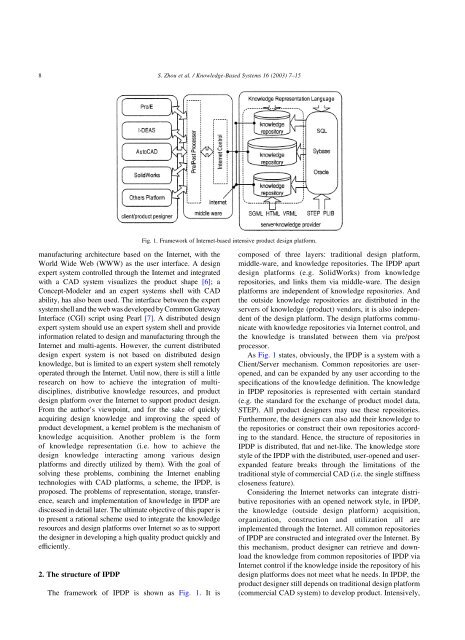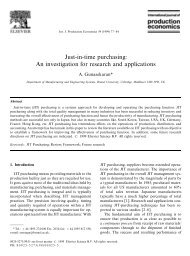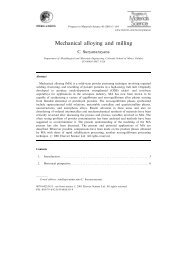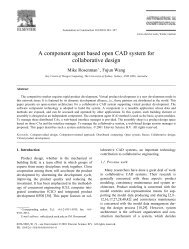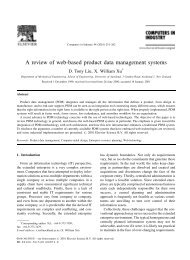Internet-based intensive product design platform for ... - GRACO
Internet-based intensive product design platform for ... - GRACO
Internet-based intensive product design platform for ... - GRACO
Create successful ePaper yourself
Turn your PDF publications into a flip-book with our unique Google optimized e-Paper software.
8<br />
manufacturing architecture <strong>based</strong> on the <strong>Internet</strong>, with the<br />
World Wide Web (WWW) as the user interface. A <strong>design</strong><br />
expert system controlled through the <strong>Internet</strong> and integrated<br />
with a CAD system visualizes the <strong>product</strong> shape [6]; a<br />
Concept-Modeler and an expert systems shell with CAD<br />
ability, has also been used. The interface between the expert<br />
system shell and the web was developed by Common Gateway<br />
Interface (CGI) script using Pearl [7]. A distributed <strong>design</strong><br />
expert system should use an expert system shell and provide<br />
in<strong>for</strong>mation related to <strong>design</strong> and manufacturing through the<br />
<strong>Internet</strong> and multi-agents. However, the current distributed<br />
<strong>design</strong> expert system is not <strong>based</strong> on distributed <strong>design</strong><br />
knowledge, but is limited to an expert system shell remotely<br />
operated through the <strong>Internet</strong>. Until now, there is still a little<br />
research on how to achieve the integration of multidisciplines,<br />
distributive knowledge resources, and <strong>product</strong><br />
<strong>design</strong> <strong>plat<strong>for</strong>m</strong> over the <strong>Internet</strong> to support <strong>product</strong> <strong>design</strong>.<br />
From the author’s viewpoint, and <strong>for</strong> the sake of quickly<br />
acquiring <strong>design</strong> knowledge and improving the speed of<br />
<strong>product</strong> development, a kernel problem is the mechanism of<br />
knowledge acquisition. Another problem is the <strong>for</strong>m<br />
of knowledge representation (i.e. how to achieve the<br />
<strong>design</strong> knowledge interacting among various <strong>design</strong><br />
<strong>plat<strong>for</strong>m</strong>s and directly utilized by them). With the goal of<br />
solving these problems, combining the <strong>Internet</strong> enabling<br />
technologies with CAD <strong>plat<strong>for</strong>m</strong>s, a scheme, the IPDP, is<br />
proposed. The problems of representation, storage, transference,<br />
search and implementation of knowledge in IPDP are<br />
discussed in detail later. The ultimate objective of this paper is<br />
to present a rational scheme used to integrate the knowledge<br />
resources and <strong>design</strong> <strong>plat<strong>for</strong>m</strong>s over <strong>Internet</strong> so as to support<br />
the <strong>design</strong>er in developing a high quality <strong>product</strong> quickly and<br />
efficiently.<br />
2. The structure of IPDP<br />
The framework of IPDP is shown as Fig. 1. It is<br />
S. Zhou et al. / Knowledge-Based Systems 16 (2003) 7–15<br />
Fig. 1. Framework of <strong>Internet</strong>-<strong>based</strong> <strong>intensive</strong> <strong>product</strong> <strong>design</strong> <strong>plat<strong>for</strong>m</strong>.<br />
composed of three layers: traditional <strong>design</strong> <strong>plat<strong>for</strong>m</strong>,<br />
middle-ware, and knowledge repositories. The IPDP apart<br />
<strong>design</strong> <strong>plat<strong>for</strong>m</strong>s (e.g. SolidWorks) from knowledge<br />
repositories, and links them via middle-ware. The <strong>design</strong><br />
<strong>plat<strong>for</strong>m</strong>s are independent of knowledge repositories. And<br />
the outside knowledge repositories are distributed in the<br />
servers of knowledge (<strong>product</strong>) vendors, it is also independent<br />
of the <strong>design</strong> <strong>plat<strong>for</strong>m</strong>. The <strong>design</strong> <strong>plat<strong>for</strong>m</strong>s communicate<br />
with knowledge repositories via <strong>Internet</strong> control, and<br />
the knowledge is translated between them via pre/post<br />
processor.<br />
As Fig. 1 states, obviously, the IPDP is a system with a<br />
Client/Server mechanism. Common repositories are useropened,<br />
and can be expanded by any user according to the<br />
specifications of the knowledge definition. The knowledge<br />
in IPDP repositories is represented with certain standard<br />
(e.g. the standard <strong>for</strong> the exchange of <strong>product</strong> model data,<br />
STEP). All <strong>product</strong> <strong>design</strong>ers may use these repositories.<br />
Furthermore, the <strong>design</strong>ers can also add their knowledge to<br />
the repositories or construct their own repositories according<br />
to the standard. Hence, the structure of repositories in<br />
IPDP is distributed, flat and net-like. The knowledge store<br />
style of the IPDP with the distributed, user-opened and userexpanded<br />
feature breaks through the limitations of the<br />
traditional style of commercial CAD (i.e. the single stiffness<br />
closeness feature).<br />
Considering the <strong>Internet</strong> networks can integrate distributive<br />
repositories with an opened network style, in IPDP,<br />
the knowledge (outside <strong>design</strong> <strong>plat<strong>for</strong>m</strong>) acquisition,<br />
organization, construction and utilization all are<br />
implemented through the <strong>Internet</strong>. All common repositories<br />
of IPDP are constructed and integrated over the <strong>Internet</strong>. By<br />
this mechanism, <strong>product</strong> <strong>design</strong>er can retrieve and download<br />
the knowledge from common repositories of IPDP via<br />
<strong>Internet</strong> control if the knowledge inside the repository of his<br />
<strong>design</strong> <strong>plat<strong>for</strong>m</strong>s does not meet what he needs. In IPDP, the<br />
<strong>product</strong> <strong>design</strong>er still depends on traditional <strong>design</strong> <strong>plat<strong>for</strong>m</strong><br />
(commercial CAD system) to develop <strong>product</strong>. Intensively,


